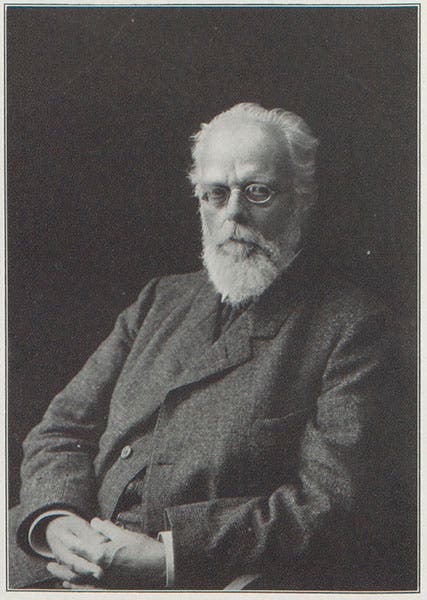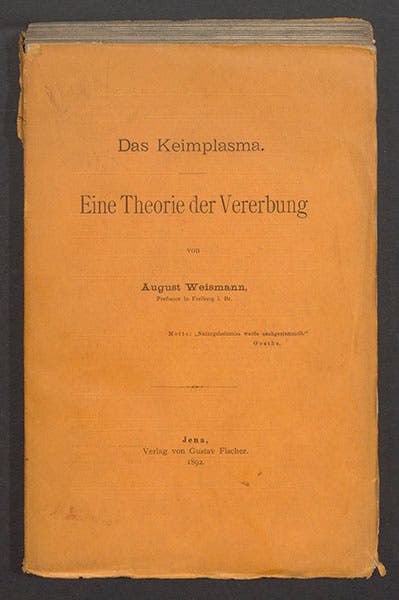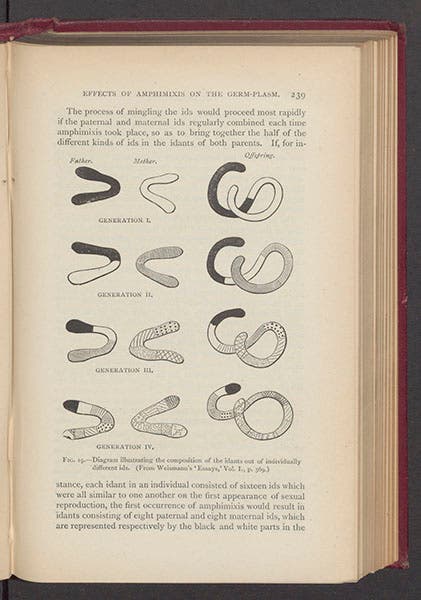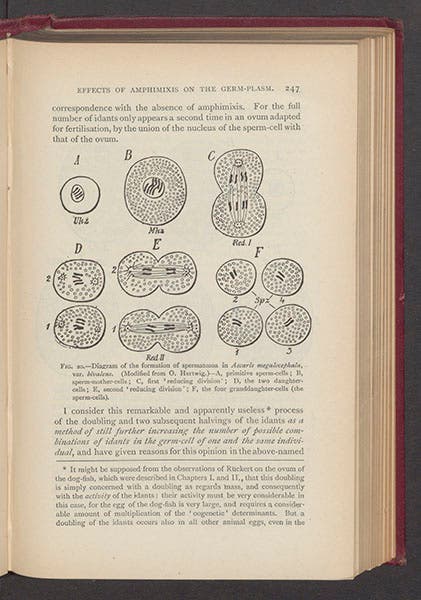Scientist of the Day - August Weismann
August Weismann, a German biologist, was born Jan. 17, 1834. Weismann became an early convert to Darwinian evolution in the 1870s, which wasn't all that uncommon, but he also subscribed wholeheartedly to Darwin’s mechanism of natural selection, a step that most of his contemporaries, English and German, refused to take. Darwin had maintained in the Origin of Species that all evolutionary change was the product of the natural selection of randomly produced variations, and he would not allow that evolution could be guided by either divine Design or changes made in or by the organism itself. The latter view was called Lamarckianism, and as a mechanism for evolution, it became increasingly popular in the last half of the 19th century, because an organism that could willfully direct its own evolution seemed preferable to one that was subject of the whims of natural variation and environmental change. Weismann, in the early 1880s, wrote an influential essay in which he shredded all the evidence and arguments for Lamarckian evolution, first by demonstrating experimentally that it was impossible to change an organism (he cut the tails off mice) and pass those changes on to its offspring, and second by demonstrating that there was no possible mechanism by which bodily changes could be fed back into the hereditary mechanism.
Expanding on the latter point, in 1892 Weismann published Das Keimplasma: eine Theorie der Vererbung (The Germ-Plasm: A Theory of Heredity), in which he argued that there are two kinds of cells: body cells, which make up our tissues and organs, and germ cells, which contain the hereditary material and produce egg and sperm cells. He maintained that there is no interaction between the two, making Lamarckian evolution impossible. This was an amazing insight at the time, since no one yet knew about Mendel (his work would not be rediscovered until 1900) and no one understood what the genetic material might be or where it was.

Portrait of August Weismann, photograph from an obituary notice in the Proceedings of the American Philosophical Society, 1915 (Linda Hall Library)
However, microscopic observations by others of the process of cell division, which showed that the nucleus did some remarkable maneuvering during cell division and seemed to duplicate a nuclear material called chromatin, was all the evidence Weismann needed to argue that the nucleus was the repository of genetic information, and that it was unaffected by anything that happened outside the nucleus. It has been often said that the ready acceptance of Mendel in 1900 was only possible because of Weismann.
We have a fine copy of the original German edition of Das Keimplasma in the History of Science Collection. It is in its original orange paper wrappers, and it is unopened, meaning that none of the gatherings have been cut, so our copy has never been read. Ordinarily, we subscribe to the belief that a book that cannot be read is of little use to the scholar, and we will slit the pages if requested. However, books that are totally unopened and in their original wrappers are scarce entities, and if is nice for a research library to have at least one book that is in the very state in which it came from the publisher. Das Keinplasma is that book for us. We intend to acquire a second copy, opened and readable, for scholarly use. Until then, we have an English translation that was published the next year, from which we drew our images.
Weismann appears from his portrait to have been a wise and possibly a kind man, but I am even more impressed by his gravestone in Freiburg, which looks like a glacial erratic that just happened to come to rest in this sepulchral setting, and which contains the engraved names of Weismann and a number of his progeny (first and sixth images). There are even baby boulders at the bottom to accommodate the overflow. I have seen the gravestones of many scientists; this is my favorite.
Dr. William B. Ashworth, Jr., Consultant for the History of Science, Linda Hall Library and Associate Professor emeritus, Department of History, University of Missouri-Kansas City. Comments or corrections are welcome; please direct to ashworthw@umkc.edu.








![Using an astrolabe to measure the depth of a well, woodcut in Elucidatio fabricae vsusq[ue] astrolabii, by Johannes Stöffler, 1513 (Linda Hall Library)](https://assets-us-01.kc-usercontent.com:443/9dd25524-761a-000d-d79f-86a5086d4774/a998eb50-55d2-4a88-ace2-a50aa5fa86e7/Stoffler%201.jpg?w=210&h=210&auto=format&fit=crop)

